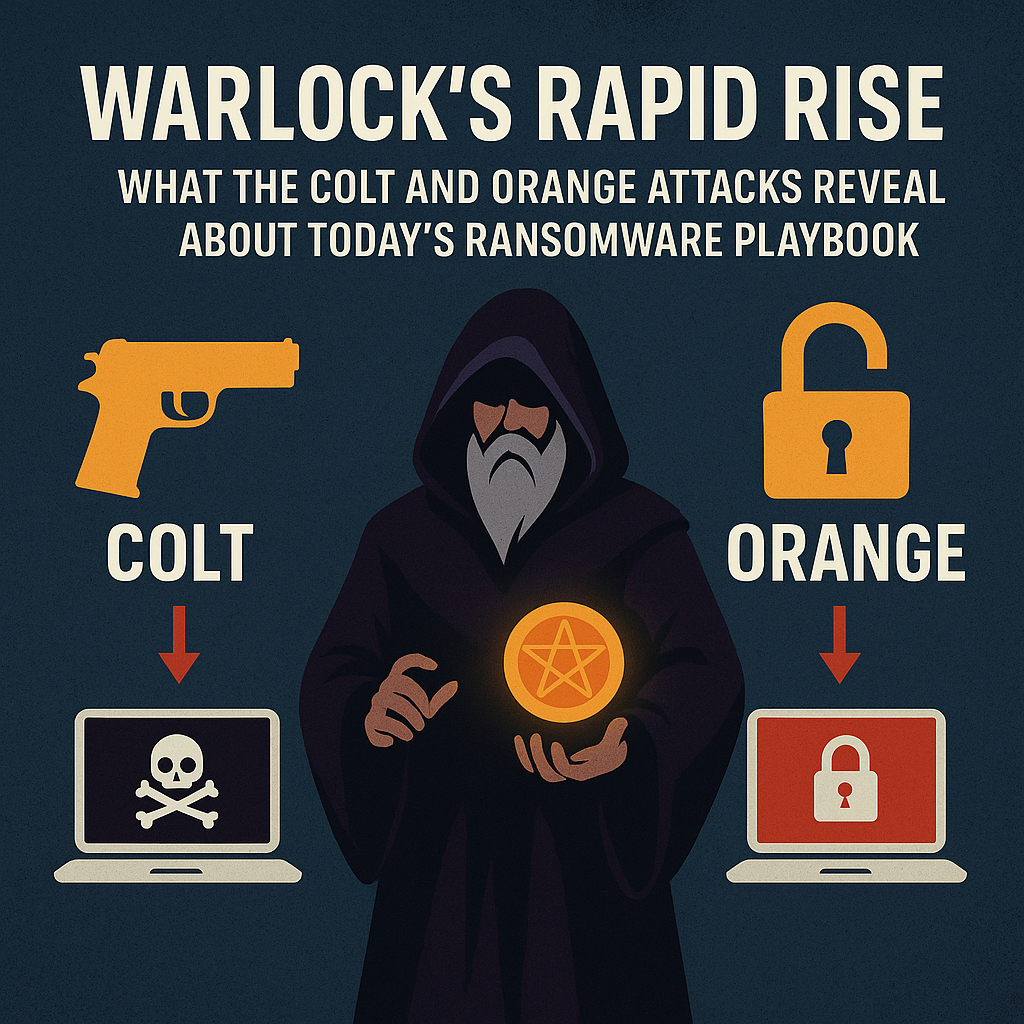Introduction
A new ransomware operator called Warlock is moving fast. In a matter of weeks, the group has claimed a string of victims and thrust itself into the conversation alongside the big names that have dominated cyber extortion in recent years. Two incidents have brought the group into sharp focus for anyone who relies on telecoms and network services: the confirmed breach at Colt Technology Services in the UK and a cyber attack at Orange affecting customers in Europe. This article unpacks what happened, how Warlock appears to operate, why telecoms are such attractive targets, and what practical steps organizations and customers can take now. The goal is simple: clear, usable guidance grounded in current techniques, not hype.
Who or what is Warlock
Warlock is an emergent ransomware operation that blends classic file encryption with aggressive data theft. This double extortion approach pressures victims by threatening to leak or sell stolen information if ransoms are not paid. Early analysis of the group’s tradecraft points to a modern toolset and a preference for exploiting exposed enterprise applications to gain initial access. Warlock’s rise does not look like an amateur experiment. It looks like a fast-maturing outfit that studied the past five years of ransomware evolution and is applying those lessons at speed.
A quick timeline: Warlock’s burst of activity
Open source monitoring of dark-web leak sites shows Warlock moving from relative obscurity to dozens of posted victims in a short window. Around 16 August, entries appeared naming multiple organizations and claiming large data volumes from several of them. That same day, both Orange and Colt were listed. Over the following weeks, counts of newly claimed victims grew into the twenties, and the cadence of posts suggested a campaign rather than a one-off. While criminal boasts are not proof by themselves, the public disruption seen at telecom providers aligns with that timeline.
What happened at Colt: scope and impact
Colt Technology Services disclosed a cyber incident in mid-August after days of service disruption that initially resembled a technical outage. Investigators later confirmed that customer data had been accessed without authorization. On Warlock’s leak site, an entry alleged the group held a vast cache from Colt, referencing a very large number of documents and offering data for sale. This is a common pressure tactic designed to force negotiation or entice third-party buyers.
Colt said the event affected business support systems rather than the core customer network. The practical exposure for customers and partners still matters. Internal documentation, contracts, financial records, and employee information can fuel fraud, targeted phishing, and downstream breaches. Even when the network stays up, the loss of trust and the compliance implications can be severe. For a service provider, that means additional scrutiny from regulators and more intensive assurance work with enterprise clients.
The likely intrusion route
Across the industry, several reports during July and August highlighted exploitation chains against internet-facing collaboration and content platforms. One widely discussed sequence targeted on-premises servers, enabling authentication bypass and remote code execution. With a single foothold, attackers could drop web shells, move laterally, harvest credentials, and ultimately deploy a locker across Windows and virtualized environments. This is a textbook example of how quickly opportunistic actors weaponize fresh enterprise vulnerabilities, especially when patching lags or segmentation is weak.
What happened at Orange: why SIM and PUK data matters
Orange reported a cyber attack that exposed customer data in its Belgian business while navigating a separate security incident in France earlier in the summer. Public statements indicated that a large number of customer records were exposed, including names, phone numbers, SIM identifiers, tariff information, and Personal Unlocking Key codes. PUK codes are intended as a safeguard when a SIM is locked. Their exposure raises immediate concerns about unauthorized SIM management if an attacker can combine those codes with other stolen information.
Orange said it blocked access to the affected system, tightened controls, and notified authorities. For business users, the sensible response includes checking for suspicious SIM changes, placing carrier-level locks where available, and reviewing account recovery flows that rely on SMS. If your organization relies on text messages for multi-factor authentication, this is the right moment to move to phishing-resistant factors that do not depend on mobile numbers.
How Warlock’s operations fit today’s threat model
Warlock’s early campaigns align with several trends defenders have been battling all year.
First, initial access through internet-facing apps is now routine. Collaboration platforms, file sharing tools, and content management systems are rich targets. When an authentication bypass becomes public, real-world exploitation tends to follow quickly. Web shells and command execution often appear within hours on servers that remain unpatched.
Second, once inside a network, many ransomware crews blend administrative utilities with well known frameworks for lateral movement, privilege escalation, and data staging. This living-off-the-land style is hard to spot if identity protections are weak. Even without bespoke malware, a determined operator can achieve domain-wide impact using tools that administrators rely on daily.
Third, double extortion has evolved into a sales-driven ecosystem. Leak sites function as both shaming platforms and marketplaces. Posts can announce auctions, set price tags for datasets, or claim that a buyer already exists. Whether or not every sales claim is true, the tactic keeps pressure on victims and introduces uncertainty for customers and partners.
Why telecoms are in the crosshairs
Targeting telecom and network service providers is a force multiplier for criminals. These companies operate business support systems with rich customer and billing data, and they run portals that partners use every day. Disrupt those systems and the impact ripples across entire ecosystems. At the same time, telecoms carry large, diverse technology estates that mix legacy platforms with modern cloud services. That complexity creates uneven patching windows and more places where an exposed application can become a foothold.
The data itself has obvious leverage. Customer identifiers, network definitions, and contract details can be used to craft believable social engineering, conduct SIM swap fraud, and reconnoiter downstream targets. The Colt and Orange events illustrate each part of that risk picture. In both cases, even if core networks stay stable, business support environments can still hold sensitive information with long-tail consequences.
Practical guidance for enterprises
The right response balances immediate containment with sustained improvement. If your organization operates on-premises collaboration or content platforms, treat the recent wave of exploitation as a stress test of how tightly you manage exposure and patch velocity.
Reduce the attack surface. Keep management and administrative portals off the public internet whenever feasible. Place high-value applications behind access brokers that enforce strong authentication. Use phishing-resistant factors such as hardware security keys for administrators and for anyone with elevated rights.
Patch with purpose. Prioritize updates that address authentication bypasses, single sign-on components, and remote execution paths. If maintenance windows are complicated, apply temporary controls like web application firewalls, IP allowlists, and emergency segmentation to buy time, then complete the vendor fix as soon as you can. Document those exceptions so they do not become permanent.
Even if encryption is contained, treat any confirmed foothold as a possible exfiltration event. Track what the adversary could have seen or staged. Preserve logs, collect volatile evidence, and prepare notifications that are specific and timely. Be clear with customers about what was exposed and what actions you are taking. Vague language breeds mistrust and prolongs the reputational hit.
Stress-test restoration. Modern ransomware operators often target backups, hypervisors, and orchestration layers. Test recovery paths from offline or immutable copies. Rehearse the exact steps to rebuild critical services when the control plane is unavailable. Measure mean time to restore from realistic scenarios, not ideal ones.
Harden third-party connectivity. Many incidents involve partners and managed service providers. Require least-privilege access with time-bound approvals and strong factors.
Guidance for customers and partners of affected providers
If you use services from a provider that has disclosed a breach, respond calmly and deliberately. Start with fundamentals. Update passwords where advised. Enable multifactor authentication on all accounts, and favor options that do not rely on text messages. If your business routes phone-based one-time codes to shared devices, revise that flow. Tie high-risk actions such as number porting to out-of-band approvals that do not depend on the number being changed.
For larger organizations, coordinate with your provider’s security team on specific controls. Examples include call-forwarding restrictions, account-level locks, alerts on SIM swaps, and dedicated escalation channels for fraud. The aim is to reduce the time between a suspicious event and your response, since many attacks rely on very short windows to intercept codes or impersonate users.
The role of open-source intelligence in understanding ransomware claims
Leak-site monitoring has become a staple for incident responders because it provides early signals even when official details are sparse. Aggregators watch dark-web posts across many operations and record the who, when, and what of claimed breaches. In Warlock’s case, public feeds captured a notable burst of entries from mid-August onward, including listings naming Colt and Orange. While criminal claims are not authoritative on their own, they can help defenders prioritize triage, initiate containment steps earlier, and prepare for customer communications before the pressure escalates.
What changes now: hard lessons from the telecom hits
Two takeaways stand out. The first is that the window between vulnerability disclosure and widespread exploitation is shorter than ever. When a bypass or remote execution chain becomes public, real-world attacks can surge within days. That compresses the time available to patch or deploy compensating controls. Teams that design maintenance processes for speed and safety will outperform those that wait for perfect visibility before acting.
The second is that the mix of data theft and extortion marketplaces means even partial compromises can have long tails. Sensitive but unglamorous documents such as network diagrams, internal emails, and routine contracts can fuel social engineering, procurement fraud, and second-order breaches months later. Treat the incident timeline as the beginning of a risk period, not the end. Build follow-up reviews into your plans and keep customers informed as your understanding evolves.
Conclusion
Warlock’s sudden visibility is not an anomaly. It is the predictable outcome of widely available ransomware tooling, a steady supply of exposed enterprise applications, and criminal economies that reward speed. The Colt and Orange incidents show how quickly a focused operator can create business disruption and downstream risk by exploiting one weak link in a complex environment.
Organizations that tighten internet exposure, accelerate patching on collaboration platforms, monitor identity with care, and rehearse recovery will fare better than those that leave difficult changes for later. Customers and partners have a role too. Lock down SIM and account recovery workflows, stay alert to targeted phishing, and ask providers specific questions about what was taken. The controls that blunt Warlock’s playbook are well understood. The challenge is applying them consistently, before the next claim lands on a leak site.






